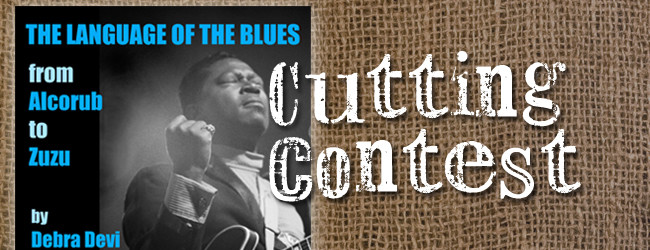
This is the latest installment in our weekly series, The Language of the Blues, in which author and rocker Debra Devi explores the meaning of a word or phrase from a blues song. Come back every week for the latest! Devi’s award-winning book, The Language of the Blues: From Alcorub to ZuZu, includes a foreword by Dr. John and is blurbed by Bonnie Raitt and Joe Bonamassa. Get your signed copy at Bluescentric.com!
Pianist Dr. John came of age in New Orleans in the 1950s, when musicians engaged in fierce jam sessions called Cutting Contests. “That’s what made a higher level of musicianship,” Dr. John said. “It’s just a sad thing that we don’t have that kind of outlet today. Where are there cutting contests anymore? Where are there all-night jam sessions anymore?”
Sometimes called a “carving contest,” or “head cutting”, a cutting contest is a jam session during which players compete for gigs, respect, and acclaim by trying to blow each other off the stage. The applause from the audience is the barometer used to grade the players and choose the winner.
“Back then, if a guy wasn’t sharp on his axe every night, somebody was goin’ come and steal his gig on a cutting contest or on a jam session,” Dr. John explained. “See, in the 1940s through the 1950s, 1960s, and into the early 1970s there were these jam sessions and cutting contests. The place in New York of course was Nicky Ungano’s, and everybody used to jam there every night.”
Ungano’s at 210 West 70th Street was where the hottest musicians gathered in New York City during the late 1960s and early 1970s. Jimi Hendrix first jammed publicly with Buddy Miles there to celebrate the New Year in 1970. The next day Hendrix announced that Miles would be in his new Band of Gypsies.
“Same thing in New Orleans,” Dr. John noted, adding, “there was always a joint to jam. What happened was all those joints went disco in the seventies. It all died with the death of free form radio and the beginnings of disco within a year.”
Kansas City had a big after-hours cutting contest scene in the 1930s that nurtured jazz greats like saxophonists Lester Young and Charlie Parker. If you want to see a re-enactment of a legendary cutting contest, check out the film Kansas City (New Line Features), Robert Altman’s re-creation of the epic battle between Coleman Hawkins and Lester Young.
Cutting contests weren’t always about snatching a gig away from another musician; sometimes they were just for fun. “I was playing with the great T-Bone Walker,” Chicago blues guitarist Jody Williams told me. “I’m having fun–both of us were having fun. He’d play a riff, you know. I’d play the same thing he’d played, note for note, and he’d look around with a big grin on his face. So he’d play something a little more complicated. I’d play the same thing identical to what he was playing, note for note. I was still in my teens at the time. So then he’d go up behind his head. I’d go up behind my head with my guitar! So we were both standing onstage playing our guitars behind our heads. But then he did one thing he was famous for…with the guitar up behind his head he would start going down slow, doing the splits. Now that was painful just for me to watch. I told him, ‘Go ahead on, man, you got it!’ ”
Experiences like this helped turn Williams into a top-notch session player who played the smoking leads on such classics as Bo Diddley’s “Who Do You Love,” Otis Spann’s “Five Spot,” and Billy Boy Arnold’s “I Was Fooled.” “Every night you could get up onstage at a different club in Chicago and go head to head with another great player,” Williams recalled. “It ain’t like that now.”
From cutting contest comes “cutting”, which is attempting to outdo a competitor in playing a solo. This use of “cut” was not, however, the origin of “cut a track,” which means to make a recording. That was derived from the fact that recordings were originally engraved or cut into wax masters (and later into metal, acetate-coated metal or glass masters).
VIDEO
Coleman Hawkins – “Lover Man”
Jody Williams – Live at Blues Estafette in Utrecht “What Kind of Gal Is That?”

